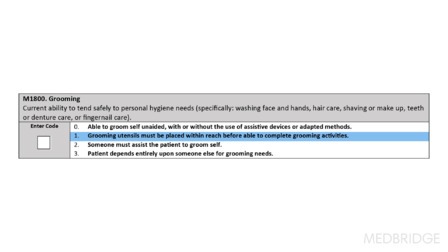OASIS-E1: New Changes, Items GG0130 and GG0170, and
Strategies for Success (Recorded Webinar)
Presented by Cindy Krafft and Joseph Brence

Although the changes coming in OASIS-E1 can be considered minor, accurate data collection requires a clear understanding of every item, every time point, every time. The session will cover what is new, what has changed, and what that means for your agency. As a “bonus”, we will talk about GG0130 and GG0170 and how they will impact HHVBP going forward. Armed with clear directions and practical strategies, data collectors make fewer errors and require less time and dime to monitor.
Learning Objectives
- Outline what will be changing moving from OASIS-E to OASIS-E1
- Connect the changes in OASIS-E1 to intentional care planning
- Establish a plan for accurate data collection using OASIS-E1
More courses in this series

OASIS-E1: Introduction to Key Concepts
Cindy Krafft

OASIS-E1: Section A
Cindy Krafft

OASIS-E1: Sections B and C
Cindy Krafft

OASIS-E1: Sections D, E, and F
Cindy Krafft

OASIS-E1: Section G
Cindy Krafft

OASIS-E1: Section GG
Cindy Krafft

OASIS-E1: Sections H, I, J, and K
Cindy Krafft

OASIS-E1: Section M
Cindy Krafft

OASIS-E1: Sections N and O
Cindy Krafft

OASIS-E1: Transfer- and Discharge-Specific Items
Cindy Krafft

OASIS-E1: M1033. Risk for Hospitalization
Cindy Krafft

OASIS-E1: M1800. Grooming
Cindy Krafft

OASIS-E1: M1810. Upper Body Dressing
Cindy Krafft

OASIS-E1: M1820. Lower Body Dressing
Cindy Krafft

OASIS-E1: M1830. Bathing
Cindy Krafft

OASIS-E1: M1840. Toilet Transferring
Cindy Krafft

OASIS-E1: M1850. Transferring
Cindy Krafft

OASIS-E1: M1860. Ambulation
Cindy Krafft

OASIS-E1: M1400. Improvement in Dyspnea
Cindy Krafft

OASIS-E1: M2020. Management of Oral Medications
Cindy Krafft

OASIS-E1: M2420. Discharge Disposition
Cindy Krafft

OASIS-E1: M1845. Toileting Hygiene
Cindy Krafft

OASIS-E1: M1870. Feeding or Eating
Cindy Krafft

OASIS-E1: Putting Knowledge Into Practice
Cindy Krafft

Candid Conversations About OASIS-E1: Assessing Function (Sections G and GG)
Terry Greenhalgh, Cindy Krafft, and Tonya Miller

Candid Conversations About OASIS-E1: Wounds (Section M)
Terry Greenhalgh, Cindy Krafft, and Tonya Miller

Candid Conversations About OASIS-E1: Medications (Section N)
Terry Greenhalgh, Cindy Krafft, and Tonya Miller

OASIS-E1: Putting Knowledge Into Practice—Focus on Function
Cindy Krafft

OASIS-E1: GG0130. Self-Care
Cindy Krafft

OASIS-E1: GG0170. Mobility
Cindy Krafft

OASIS-E1: New Changes, Items GG0130 and GG0170, and Strategies for Success (Recorded Webinar)
Joseph Brence and Cindy Krafft

OASIS-E1: Quick Guide to PDGM and HHVBP Items (Text-Only)
Cindy Krafft